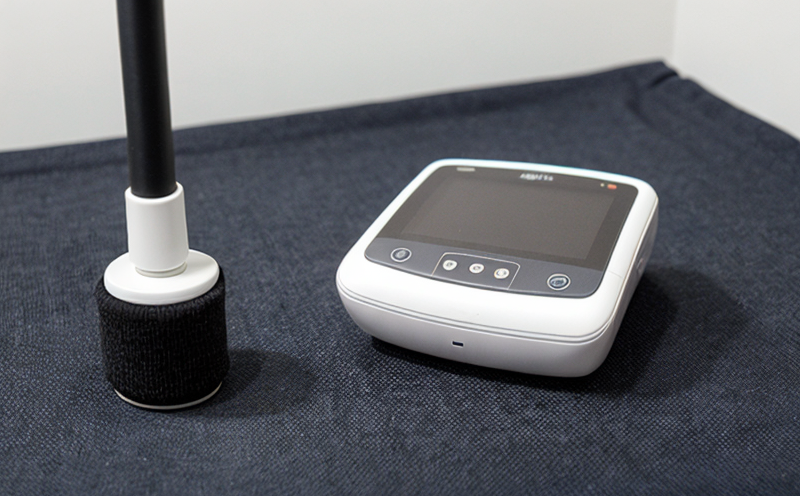EN 1149-3 Protective garments Charge decay test for conductive fabrics
The EN 1149 series of standards provides guidelines on the electrical characteristics and performance requirements for protective clothing designed to protect workers from electric shock. The specific standard, EN 1149-3, focuses on the charge decay test which is critical for determining the suitability of conductive fabrics used in such garments.
The goal of this test is to ensure that the fabric maintains its conductivity over time and under various environmental conditions. Conductive textiles are essential in industries where workers must be protected from electrical hazards, such as manufacturing plants, power generation facilities, and construction sites. The test evaluates how quickly a charge decays on the surface of the fabric when exposed to an electric field.
The testing process involves several key steps:
- Preparation: Conductive fabrics are cut into standard specimens that match the dimensions specified in EN 1149-3.
- Charging: The specimen is charged with a known amount of electrical charge using a calibrated instrument.
- Decay Measurement: Over time, the electric charge on the fabric's surface is measured to determine its decay rate. This measurement provides insight into the fabric’s ability to dissipate or retain electric charge effectively.
The test results are compared against specified acceptance criteria outlined in EN 1149-3. Compliance with these criteria ensures that the protective clothing meets safety standards and can be trusted for use in high-risk environments.
For industries like manufacturing, where workers may encounter electrical equipment or machinery, this testing is particularly crucial. It helps ensure that garments do not become a source of electric hazard but instead provide an additional layer of protection. Understanding the specifics of EN 1149-3 allows quality managers and compliance officers to make informed decisions about garment selection.
R&D engineers responsible for developing new conductive fabrics can also benefit from this knowledge by tailoring their materials to meet these stringent standards. This ensures that any innovations in textile design are not only technologically advanced but also safe and reliable.
Benefits
- Enhanced Safety: Ensures that conductive fabrics used in protective garments effectively dissipate electrical charges, reducing the risk of electric shock for workers.
- Compliance with Standards: Helps companies meet international safety standards, thereby avoiding legal and operational risks associated with non-compliance.
- Improved Product Reputation: Demonstrates a commitment to worker safety, which can enhance the company's reputation in the market.
- Increased Worker Confidence: Knowing that their protective clothing has been rigorously tested boosts morale and trust among employees.
Quality and Reliability Assurance
The quality assurance process for EN 1149-3 involves several critical steps to ensure that the testing is conducted accurately and consistently. Quality managers play a crucial role in overseeing these processes to maintain high standards.
Preparation: Specimens are prepared with precision following the guidelines provided in EN 1149-3 to ensure uniformity across tests. This step includes selecting appropriate materials, cutting specimens accurately, and ensuring they are free from defects that could affect the test results.
Calibration: Instruments used for charging and measuring charge decay must be calibrated regularly to guarantee accurate measurements. This step is essential in maintaining reliability and consistency of the test results over time.
Data Analysis: After each test, data from multiple specimens are analyzed to determine compliance with specified criteria. Any anomalies or deviations require re-testing or investigation into potential issues within the testing process.
The use of advanced instrumentation and software tools further enhances quality assurance by providing real-time data analysis and visualization capabilities. This allows for immediate identification of any discrepancies during the test cycle, ensuring that only compliant products are released to market.
International Acceptance and Recognition
The EN 1149 series of standards is widely recognized across Europe and beyond. It has been adopted by many countries as a benchmark for electrical protective clothing, reflecting its importance in ensuring worker safety.
Incorporating EN 1149-3 into procurement processes ensures that the chosen suppliers adhere to these high standards. Compliance with this standard not only meets regulatory requirements but also enhances the overall reliability and effectiveness of the protective garments used by companies globally.
Many industries have specific requirements related to electrical safety, making EN 1149-3 an integral part of their quality assurance programs. By ensuring compliance through rigorous testing, companies can demonstrate their commitment to worker safety while also gaining competitive advantages in international markets.





